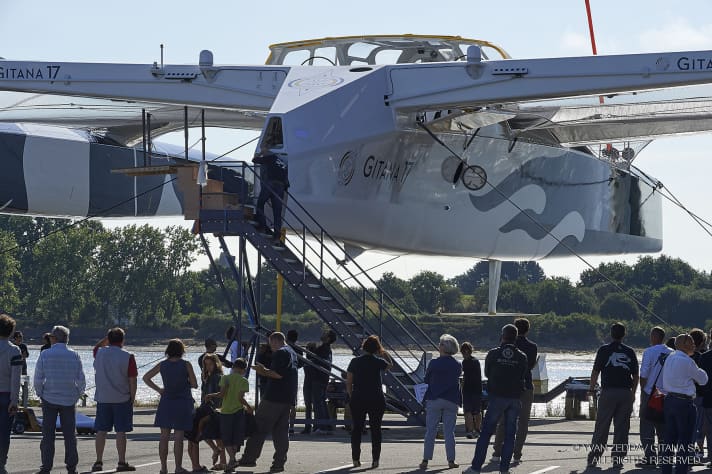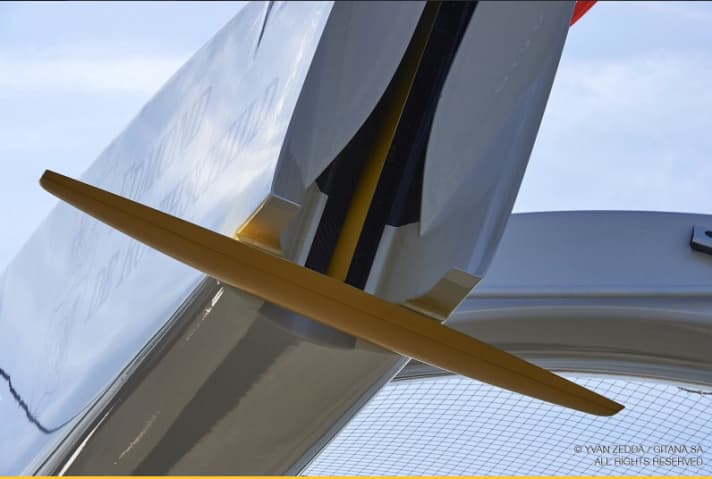

The Rothschild family's Gitana team and skipper Sébastien Josse spent a year and eight months building the new maxi "Edmond de Rothschild", which is also designed to sail single-handed over long distances. The launch in front of the Multiplast shipyard in Vannes was the first opportunity to see how this will work. The 32-metre tri has six appendages and by far the largest T-foils ever fitted to an offshore trimaran. "The boat continues the team's innovative tradition," said Benjamin Rothschild at the launch.

Until now, it was considered very difficult to transfer the concept of flying cats from the America's Cup to the oceans. This is because it was previously considered too dangerous for the boats to sail in high swells of eight or nine metres.
But this is exactly what the design by designer Guillaume Verdier is supposed to do; he was also instrumental in the New Zealanders' cat for the America's Cup. "The idea was to build the first offshore tri that flies reliably," says the designer. From a wind speed of 14 knots, the giant tri should only sail on its foils. The centreboards are L-shaped in a similar way to the cup boats, with adjustable T-foils on all three rudders of the tri as well as a T-foil in the centre hull. "The centre one is primarily there to dampen rolling movements in rough seas," says Verdier. These were the biggest problem when testing the concept with the team's modified old Mod 70.

The next few weeks would now bring a lot of coordination work. "At Team New Zealand, we worked with 80 people at times to answer the sailors' questions. So Sébastien Josse has a lot of work to do." The cat is actually considered the perfect platform for foiling, but also too prone to capsizing for the high seas. So the idea for the Tri was developed further as a compromise.
The skipper, who was recently eliminated from the Vendée Globe with his foiling Open 60 after breaking, is already looking forward to the tests: "I can hardly wait to sail the boat. But we also have to be clear: These days, records are only broken by teams that have been working on the boats and projects for a very long time, usually years." The aim is to start with the boat at the double-handed Jacques Vabre regatta in November, then sail the Route du Rhum single-handed in 2018 and compete in the first single-handed non-stop race around the world with the Maxi-Tris in 2019.
A closer look at the boat shows how fast progress is currently being made in this area, especially in comparison to the rival team "Banque Populaire", which presented its Maxi-Tri for the same programme at the end of 2015. Its designers, the VPLP design office, explained that their tri would not be a "pure" foiler, as a small part of the main hull and the lee float would always "flit" over the water. Accordingly, its T-foils are smaller, while the floats and the hull are significantly more voluminous.
The "Edmond de Rothschild" surprises with rudder T-foils, which are protected by huge fairings that look rather clunky. But they are necessary because the rudders of the side hulls can be raised while sailing. This is necessary to protect the foils from wave impact at high speed and swell from the side. In addition, the rudders can fold up if flotsam is rammed.
The boat has now been rigged and will soon be making its first test runs off the French coast. Designer Guillaume Verdier only hinted at what can be expected: "Speeds up to a maximum of 50 or 54 knots are conceivable, then cavitation sets in." He also believes that distances of 900 nautical miles in 24 hours (the current record is 908.2 for the 132-foot tri "Banque Populaire V") are realistic.
